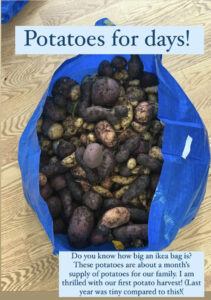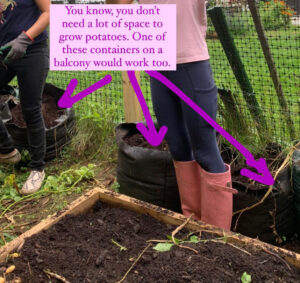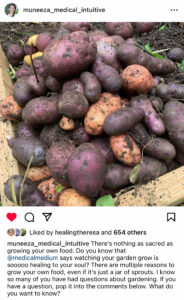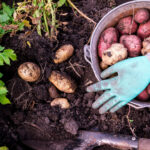Do you know what’s easier than you think?
Growing your own food at home!
Want to know one of my favorite home-growing discoveries?
How to grow your own potatoes!
You can grow potatoes in a pot on your balcony, in a raised garden bed in your backyard, and even in large containers or bags that you put down just about anywhere!
MY GARDENING LIGHT BULB MOMENT
I’ll never forget the eureka moment I had when I started growing my own food at home.
It’s powerful to realize that we can take the food we have and create more food any time we wish.
Most of us are so used to getting all our food from the grocery store that we forget we have access to our own food sources no matter where we live.
We can feed ourselves any time we choose. All we need is soil, seeds, water, and sunlight. Share on XFew feelings are more satisfying than biting into a perfectly juicy tomato you grew from seed.
Sure, there’s effort involved. And growing enough to feed a family long-term is a whole other story. But supplementing our grocery trips with homegrown food gives us more than cheap, nutritious produce.
Planting and raising a garden connects us to our food, the Earthly Mother, and God in a profound way that cannot be duplicated in any other way. Share on XGROWING GUIDE: POTATOES
Potatoes are surprisingly easy to grow at home. They are PERFECT for gardening newbies and yield the most satisfying results.
Step 1: Get your seed potatoes
Potatoes sprout naturally – a miracle all on its own!
This is one reason they’ve been a crucial staple crop for generations worldwide. Seed collecting couldn’t be easier! Just grab a mature potato and get growing!
Purchasing “seed potatoes” is a way to ensure that the potatoes you are using to grow more are free of disease. This is not required but recommended for anyone starting out with home-growing.
Find a source you trust, ideally organic, and pick your favorite varieties to grow at home!
Step 2: Sprouting
Most seed potatoes will arrive at least partially sprouted. Allowing them to sprout further before planting is still a good idea!
Whether you’ve purchased seed potatoes or decided to sprout organic potatoes you’ve purchased from a store (or potatoes from your previous harvest!), place your seed potatoes in a sunny spot.
Ensure the temperature remains at 60-70 degrees Fahrenheit – room temperature is perfect! Keep sprouting potatoes indoors in early spring.
If your seed potatoes are large (larger than about 3 inches), you can slice them into smaller pieces, which will still sprout on their own.
Sprout for at least two weeks and up to six before planting!

Step 3: Planting
Potatoes like mineral-rich soil full of nutrients. Compost or good organic fertilizer are great tools! Supplement your soil with a store-bought compost mix if you think your soil would benefit.
Be sure to till the soil to loosen it up before planting to allow for good drainage and airflow. A pH of 5.0 to 7.0 is ideal but not essential.
You can plant between two weeks after the last frost and 12 weeks before the first frost if you are in a location with winter!
When your seed potatoes are ready, plant them about 3-4 inches below the soil’s surface and cover entirely with your soil and compost mixture – you want the sprouts to reach up a bit to find the sun.
If you’re planting in the ground and are planting several seed potatoes, leave at least 12 inches of space between each plant.
If you’re planting in a pot, container, or bag, one single seed potato will grow best if the container isn’t large. If you have a large growing bag, you can plant 2-3 seed potatoes in a triangular position!
Choose a sunny spot in your garden or place your containers somewhere they’ll receive plenty of sunlight. Potato plants love the sun!
Step 4: Caring for your potato plants
Potato plants like moisture, so water regularly with clean water. Don’t water so much that the soil is drenched – consistent light dampness works great.
There’s a practice called “hilling,” which helps protect growing potato plants from sun exposure.
Every time your plants grow about six inches, gather your soil and compost mixture and re-bury the base of the growing potato stalks. Once the leaves have fully formed and are a nice dark green, you can stop hilling. Do this 2-3 times.
You’ll love when you smell potato blossoms for the first time; I know I did! These beautiful white flowers will make you smile and feed your local bee population!
After flowering, your potato plants will brown and die – this is normal! Cut away any brown leaves and continue to care for your plants normally until all above-ground growth has withered.

Step 5: Harvesting
Once your potato plants have stopped flowering, they are ready for harvesting! This typically takes about 10-12 weeks after your first hilling process.
If you harvest as soon as the flowers disappear, these will be “new potatoes.” They will have very thin skin and should be eaten right away.
If you wait until the plants above the soil die entirely, you will have more mature potatoes with thicker skin. These can be stored in a cool dark spot for months!
For fully mature potatoes, wait about two weeks after the last plant above ground has died.
Now the fun part! Get out your spade and gloves and dig out the treasures waiting for you under the soil surface!
Check out these videos of my daughters and me harvesting our 2021 potato haul! We were so pleased with our yield and enjoyed our homegrown potatoes for months!
Check out our potato harvest on my Instagram highlight!
If your potatoes still have green under their skin, they have not matured and are unsafe to eat.
If your potatoes begin to sprout, they are overripe and are no longer safe to eat! They will sprout when exposed to sunlight and warmth.
Once you’ve dug up your harvest, you’ll want to place the potatoes somewhere cool, dry, and well-shaded to let them cure. Curing will allow the potatoes to mature further so they keep well (reminder to eat new potatoes immediately; they don’t require curing).
Cure your potatoes for at least three days and as long as two weeks before cleaning them thoroughly.
Then pop them into your steamer for a delicious meal that YOU created with help from the energies of Nature. Or store them in a cool, dark, dry space for later!
Learn more about harnessing an understanding of the adrenal glands to overcome fatigue and boost your energy! Take my FREE ENERGY QUIZ now and receive custom recommendations to boost your energy and TWO FREE RESOURCES to help you take your energy to the next level.
POTATO RECIPES
I can’t write about potatoes without sharing some of my favorite recipes.
Just thinking of potatoes, my mouth begins to water. There’s something so satisfying and nourishing about potatoes!
And they are one of our most versatile foods – great for everything from waffles to tortillas to soup or salad.
Get flavor-packed inspiration for your freshly harvested crops below!
- Pakistani Potato Masala
- Guilt-Free Grain-Free Potato Wraps
- Potato Air Fries
- Creamy Roasted Garlic Mashed Potatoes
- Classic Summer Potato Salad
- Muneeza’s Spicy Potato Pea Mash
- Split Pea & Red Potato Soup
- Grain-Free Vegan Spanakopita
- Garlicky Potato Soup
- Potato Asparagus Soup
Are you looking for more recipe inspiration using only healthy foods? Check out my Top 16 Healing Recipes blog for more!
And if you’re feeling inspired to get your hands dirty and build your garden, visit my past gardening blogs, 7 Simple Tips to Start Your Garden This Spring, Tips for Seed Buying and Garden Prep, and Growing Sprouts for those of you who want to grow but only have a window sill to start with!
THE MIRACLE OF HOME-GROWN FOOD
When we grow our own food, there is more going on than meets the eye.
Anthony William, the Medical Medium ®, who has inspired much of my healing journey and practice, has shared that when we grow our own food, the plants attune themselves to our needs as we care for them.
For example, potatoes have specific properties and nutrients that support our health. When you grow your own potatoes, your potatoes will adjust their levels of nutrients to match what will serve your body best.
This is true for any plant you grow for consumption, from fruits and vegetables to herbs and spices.
Every crop you raise and harvest is customized to support your well-being. How amazing is that?
Are you struggling with a health condition, looking for answers to your chronic illness, or seeking a like-minded community focused on living a life based on health and wholeness?
We’d love to invite you to join our Intuitive Healing Community!
Get support, get answers, and connect with hundreds of people worldwide who are healing chronic illness and sharing their experiences to empower others.
GETTING BACK TO BASICS
There are so many benefits to building a relationship with food-yielding plants.
Our ancestors developed a deep relationship with plants and how to maximize their ability to sustain human life.
In an increasingly uncertain world, building knowledge of how to work with the Earthly Mother, the rhythms of Nature, and specific crops will only serve us.
By growing our own food within our families, we also create the opportunity for younger generations to restore lost knowledge of how to care for edible plants.
We can equip our children and grandchildren to rely on themselves and take advantage of the convenience of well-supplied grocery stores.
Empowerment comes from knowledge that builds confidence in our ability to provide for ourselves.
Passing on the gift of that empowerment to our young people, teaching them to care for themselves and the gifts of our planetary home, is priceless.
To your health and peace,
Muneeza








